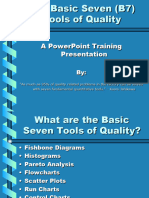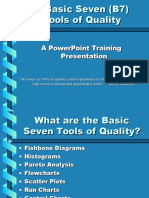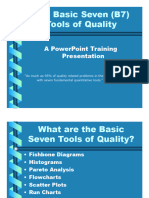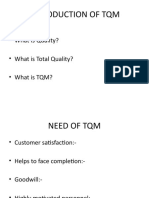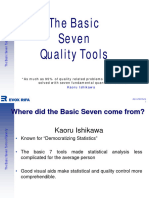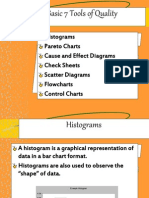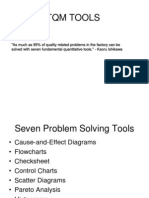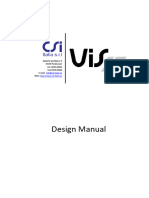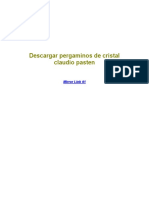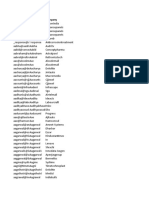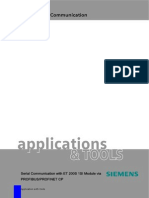The Basic Seven (B7) Tools of Quality
A PowerPoint Training Presentation
By Keith H. Cooper
"As much as 95% of quality related problems in the factory can be solved with seven fundamental quantitative tools." - Kaoru Ishikawa
�What are the Basic Seven Tools of Quality?
Fishbone Diagrams Histograms Pareto Analysis Flowcharts Scatter Plots Run Charts Control Charts
�Where did the Basic Seven come from?
Kaoru Ishikawa
Known for Democratizing Statistics
The Basic Seven Tools made statistical analysis less complicated for the average person
Good Visual Aids make statistical and quality control more comprehendible.
�The Basic Seven (B7) Tools of Quality
Fishbone Diagrams
No statistics involved Maps out a process/problem Makes improvement easier Looks like a Fish Skeleton
�Constructing a Fishbone Diagram
Step 1 - Identify the Problem Step 2 - Draw spine and bones
Example: High Inventory Shrinkage at local Drug
Store
Shrinkage
�Constructing a Fishbone Diagram
Step 3 - Identify different areas where problems may arise from Ex. : High Inventory Shrinkage at local Drug Store
employees
Shrinkage
shoplifters
�Constructing a Fishbone Diagram
Step 4 - Identify what these specific causes could be
Ex. : High Inventory Shrinkage at local Drug Store
Shrinkage
Expensive merchandise out in the open No security/ surveillance
Anti-theft tags poorly designed
shoplifters
�Constructing a Fishbone Diagram
Ex. : High Inventory Shrinkage at local Drug Store
employees
attitude training new trainee benefits
practices
Shrinkage
Expensive merchandise out in the open
Anti-theft tags poorly designed
No security/ surveillance
shoplifters
�Constructing a Fishbone Diagram
Step 5 Use the finished diagram to brainstorm solutions to the main problems.
�The Basic Seven (B7) Tools of Quality
Histograms
Bar chart Used to graphically represent groups of data
�Constructing a Histogram
From a set of data compute sum mean (x) Max Min Range (max-min)
�Constructing a Histogram
Use range to estimate beginning and end Calculate the width of each column by dividing the range by the number of columns
Range
# of Columns
= Width
�Acme Pizza Example
Lets say the owner wants a distribution of Acmes Thursday Night Sales
Data Set from last Thursday(slices)
02122413121224341432232122122142 21212212121212121222121211222314 22322212322422441222322122421242 1721223121121222122121222424
�Acme Pizza Example
Mean = 2.032258 Max = 7 Min = 0 Range = 7
Question For 7 columns what would the width be?
Range/Columns=7/7=1 slice
�Acme Pizza Example
Histogram
70 60 50 40 30 20 10 0 1 2 3 4 5 6 7 8 12 0 0 1 33 65
Slices of Pizza
�Constructing a Histogram
How is this helpful to Acme? 2 slices of pizza most common order placed Distribution of sales useful for forecasting next Thursdays late night demand If you were an Acme manager how could you apply this information?
�The Basic Seven (B7) Tools of Quality
Pareto Analysis
Very similar to Histograms Use of the 80/20 rule
Use of percentages to show importance
�Acme Pizza (part 2)
Slices 0 1 2 3 4 5 6 7 Frequency 1 33 65 8 12 0 0 1 % .3 13.09 25.79 3.17 4.76 0 0 .3
�Acme Pizza (part 2)
The completed Pareto Analysis results in the following graph:
70 60 50 40 30 20 10 0 1 2 2
3 4
4 3
5 7
6 5
7 6
Slices of Pizza
�Acme Pizza (part 2)
Critical Thinking How does the Pareto Analysis differ from the Histogram?
How can this be a useful tool to the Acme boss?
�The Basic Seven (B7) Tools of Quality
Flowcharts
A graphical picture of a PROCESS
Process
Decision The process flow
�Flowcharts
Dont Forget to:
Define symbols before beginning Stay consistent
Check that process is accurate
�Acme Pizza Example (Flowchart)
Window (start) Take Customer Order
Money?
yes no
Lockup Put More in
Oven
Get Pizza
no
yes
Time to close?
2 Pies Available?
no
yes
Take to Customer
�How can we use the flowchart to analyze improvement ideas from the Histogram?
Window (start) Take Customer Order
Money?
yes no
Lockup Put More in
Oven
Get Pizza
no
yes
Time to close?
2 Pies Available?
no
yes
Take to Customer
�Want some practice?
Make a flowchart for:
Taking a shower Cooking dinner Driving a car Having a party Creating a Flowchart
Any other processes you can think of?
�The Basic Seven (B7) Tools of Quality
Scatter Plots 2 Dimensional X/Y plots Used to show relationship between independent(x) and dependent(y) variables
�Acme Pizza (Scatter Diagram)
Minutes Cooking 10 45 30 75 60 20 25 Defective Pies 1 8 5 20 14 4 6
In this simple example, you can find the existing relationship without much difficulty but
�Scatter Diagrams
Easier to see direct relationship
25 20 15 10 5 0 0 20 40 60 80
Time Cooking (minutes)
�Scatter Diagrams
As a quality tool What does this tell Acme management about their processes? Improvements?
25 20 15 10 5 0 0 20 40 60 80
Time Cooking (minutes)
�The Basic Seven (B7) Tools of Quality
Run charts
Time-based (x-axis) Cyclical Look for patterns
�Run Charts
Slices/hour
8 9 10 11 12 1 2 3 4
8 9 10 11 12 1 2 3 4 8 9 10 11 12 1 2 3 4
Time
PM- AM
Thursday Week 1
PM- AM
Thursday Week 2
PM- AM
Thursday Week 3
�The Basic Seven (B7) Tools of Quality
Control Charts
Deviation from Mean Upper and Lower Specs Range
�Control Charts
Upper Limit
Lower Limit Unacceptable deviation
�Control Charts
Acme Pizza Management wants to get in on the control chart action
Average Diameter = 16 inches Upper Limit = 17 inches
Lower Limit = 15 inches
�Acme example Control Charts
Upper Limit
17 inches
16 inches=
Lower Limit 15 Inches Small Pie
�Acme example #50 Control Charts
Pies within specifications were acceptable
One abnormally small pie is uncommon Should be examined for quality control
�Summary
Basic Seven Tools of Quality
Measuring data Quality Analysis Democratized statistics
�Bibliography
Foster, Thomas. Managing Quality. An Integrative Approach. Upper Saddle River : Prentice Hall, 2001. Stevenson, William. Supercharging Your Pareto Analysis. Quality Progress October 2000: 51-55. Dr Kaoru Ishikawa. Internet http://www.dti.gov.uk/mbp/bpgt/m9ja00001/m9j a0000110.html. 16 February 2001. Chemical and Process Engineering. Internet. http://lorien.ncl.ac.uk/ming/spc/spc8.htm. 17 February 2001.







